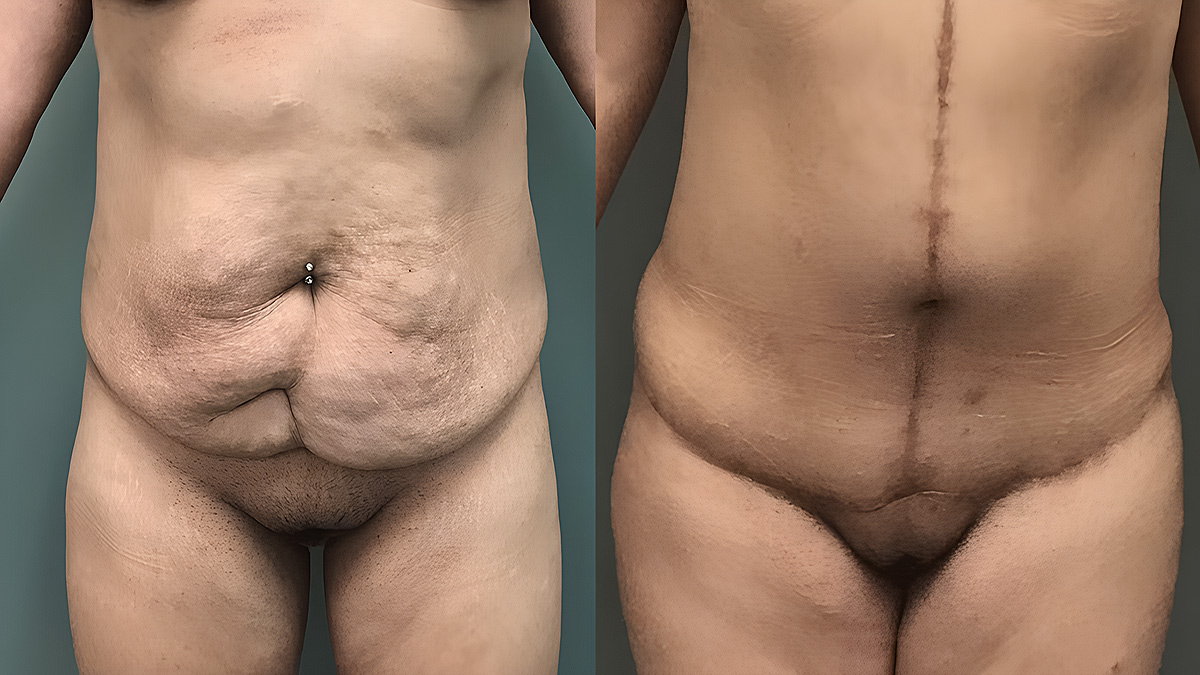
For many women, especially after pregnancy, a lingering belly bulge that just won’t go away can be deeply frustrating. You’re eating well, staying active, and doing all the “right” things - yet your core doesn’t feel like it used to. One possible reason? Diastasis recti.
Dr. Michael Baumholtz, a dual-board-certified Plastic Surgeon based in San Antonio, TX, helps women understand and address this condition with both compassion and expertise. In this article, we’ll explore what diastasis recti is, why it matters, and how it can be effectively repaired.
What Is Diastasis Recti?
The Basics
Diastasis recti is a condition where the rectus abdominis or “six-pack” muscles separate along the midline. This separation is caused by the stretching of the connective tissue known as the linea alba, most commonly during pregnancy. The growing uterus pushes outward, and in some women, the tissue doesn’t fully recover. Diastasis recti can also occur with significant non-pregnancy weight increase followed by weight loss.
The gap can widen to more than two centimeters and often presents as a visible ridge or bulge when sitting up or straining. Left untreated, this separation may worsen with time, particularly under continued strain or in the absence of supportive core function. The bulge is more than cosmetic - it's a signal that the abdominal wall is not functioning as it should and it will not resolve on its own.
Who It Affects
While frequently linked to pregnancy, diastasis recti can occur in women of various ages and lifestyles. Women who have experienced multiple pregnancies, carried large babies, or had pregnancies later in life may be more susceptible. Those who have gained or lost significant weight, lifted heavily without proper technique, or have a genetic predisposition to weak connective tissue are also at risk. The condition is more common than many realize, affecting women from their 20s to their 70s.
Why It’s More Than Just “Cosmetic”
Hidden Symptoms
The most obvious sign of diastasis recti is the abdominal bulge, but the condition goes deeper. It can weaken the core's ability to stabilize the body, which in turn leads to back pain from compensatory muscle overuse. Poor posture often develops as the body adjusts to the lack of support, and simple daily tasks - like lifting children or getting out of bed - become uncomfortable. The abdominal separation can contribute to pelvic floor dysfunction, resulting in issues such as urinary incontinence. Digestive problems, including bloating and constipation, are also common due to altered pressure in the abdominal cavity.
These symptoms are frequently misattributed to aging, fatigue, or unrelated health issues. However, a careful physical assessment, often performed by experts like Dr. Michael Baumholtz, can pinpoint diastasis recti as the root cause and guide an effective path to relief.
Emotional Toll
The emotional impact is equally significant. Women often internalize feelings of failure or inadequacy when their postpartum body doesn’t “bounce back.” Confidence may decline, and some withdraw from activities they once enjoyed - beach days, gym classes, or intimacy. It’s not unusual to hear women say they no longer recognize their reflection. Understanding that diastasis recti is a medical condition - not a personal shortcoming - can be the first step toward recovery.
Can Diastasis Recti Be Fixed Without Surgery?
Physical Therapy & Exercises
For many women, specialized physical therapy offers meaningful relief. Treatment typically focuses on strengthening the transverse abdominis, the body’s deepest abdominal muscle. This involves carefully guided core exercises that avoid strain on the separated muscles, posture retraining, and often, coordination with pelvic floor therapy. These programs, often led by therapists trained in postpartum care, aim to close the gap gradually and restore core function.
However, while non-surgical treatment can strengthen the core, if the muscles remain separated, they may not function optimally.
When Conservative Methods Fall Short
When non-surgical options reach their limit, surgical repair may be necessary. Women who still experience instability, discomfort, or a visible bulge after diligent therapy may find long-lasting results through surgical intervention. Especially in cases where the connective tissue has thinned beyond recovery, surgery is often the most effective way to restore both form and function.
This is when consultation with a seasoned Plastic Surgeon like Dr. Michael Baumholtz becomes critical. He evaluates whether surgery is appropriate based on each patient’s history, physical findings, and goals.
See Before and After Photos of Tummy Tuck Surgery
Surgical Repair: How Dr. Michael Baumholtz Approaches It
The Procedure
Surgical correction of diastasis recti typically takes place during an abdominoplasty, or tummy tuck. In this procedure, Dr. Michael Baumholtz carefully brings the separated muscles back to the midline and sutures them together to recreate a stable abdominal wall. This restores core strength and helps improve posture and body mechanics. Excess, overstretched skin is also removed, and liposuction may be used to refine the waistline. The belly button is repositioned to maintain a natural look. This comprehensive approach not only improves physical function but also enhances aesthetic balance.
The procedure is performed under general anesthesia, and patients are closely monitored throughout. While recovery takes time, the results are enduring and often life-changing.
Dr. Baumholtz’s Technique
At his clinic in San Antonio, TX, Dr. Michael Baumholtz uses photographs, examination and measurements to map the patient’s anatomy and surgical plan. His technique is grounded in precision and years of surgical expertise. In some cases - particularly with complex revisions or suspected internal concerns - a CT scan may be recommended for a more detailed view. If appropriate, he may also request records from previous surgeries to better understand what was done and how to plan safely moving forward. Whether the patient needs primary repair or revision from a previous surgery, Dr. Baumholtz’s approach is both meticulous and personalized. His ability to integrate functional repair with aesthetic goals sets him apart as a trusted specialist.
Is It Right for You?
Candidates for surgery are generally in good health, do not plan future pregnancies, and have symptoms affecting their daily life. These symptoms might include persistent back pain, visible abdominal bulge, trouble with lifting or physical activity, or dissatisfaction with how their core looks and feels. If you’ve tried therapy and still don’t feel strong or supported, surgery may be the next step. In every case, Dr. Michael Baumholtz discusses the risks, benefits, and recovery expectations so you can make an informed decision.
Life After Repair: What to Expect
Recovery Snapshot
Recovery begins the moment you leave the operating room. Most women are up and walking the same day and resume light activities within two weeks. Lifting and vigorous exercise are restricted for 12 weeks to protect the surgical repair. Over the following months, the core continues to strengthen and tighten. Scars mature and fade with time, and many patients support this healing with scar care routines or non-surgical treatments.
Throughout your recovery, Dr. Michael Baumholtz and his team are by your side. From detailed instructions to scheduled check-ins, you’ll receive the support and answers you need to heal well and return to the life you love.
Emotional Wins
Many women report feeling stronger, more stable, and more confident within weeks. Clothes fit better. Exercise feels more rewarding. Posture improves. But more than that, they begin to feel whole again - like their body is finally in sync. These emotional gains are just as important as the physical transformation.
Why Choose Dr. Michael Baumholtz in San Antonio, TX?
Dr. Michael Baumholtz offers the rare advantage of being certified in both General Surgery and Plastic Surgery. This dual background means he understands the deeper anatomy of the abdominal wall and brings a functional perspective to aesthetic procedures. He routinely treats complex and revision cases, making his practice a destination for patients seeking thoughtful, comprehensive care.
At his San Antonio clinic, consultations are thorough and collaborative. Dr. Baumholtz takes the time to understand your concerns and goals, setting realistic expectations and ensuring you’re well-informed at every step.
With a reputation built on skill, honesty, and results, Dr. Michael Baumholtz is a trusted name in diastasis recti repair.
FAQs About Diastasis Recti and Repair
Can diastasis recti affect balance or coordination?
Yes, since the abdominal muscles play a key role in core stability, diastasis recti can make it harder to balance or move efficiently. Many women describe feeling "off-center" or unsteady when walking or exercising.
Is it possible to have diastasis recti years after childbirth?
Absolutely. Diastasis recti can persist or even worsen years after pregnancy if not properly diagnosed or treated. Some women only discover the issue when they seek answers for unexplained back pain or abdominal weakness.
How do I know if my bulge is due to diastasis recti or something else like a hernia?
A consultation with an experienced Plastic Surgeon like Dr. Michael Baumholtz can help determine the cause. Physical examination and imaging are often used to differentiate between diastasis and hernias, which can sometimes coexist.
Can weight training or crunches make diastasis recti worse?
Yes. Incorrect exercise techniques, especially those that increase intra-abdominal pressure, can worsen the separation. That’s why supervised therapy or guided instruction is important if you're working on your core.
Will I regain core strength after surgery?
Most women report significant improvements in core strength following surgical repair. Once the muscles are reconnected and healed, physical activity becomes more comfortable and productive.
Can I have the surgery even if I’m not a mom?
Yes. Diastasis recti isn't limited to postpartum women. It can occur in anyone with repeated abdominal pressure or weight fluctuations. Surgical repair is based on symptoms, not maternity history.
What kind of clothing or support is helpful after surgery?
Post-surgical garments like compression binders help support the abdominal wall and reduce swelling. Dr. Baumholtz will recommend appropriate support wear during your recovery phase.
Medical References
- Diastasis recti abdominis - a review of treatment methods
Journal: Ginekologia Polska (PubMed)
https://pubmed.ncbi.nlm.nih.gov/29512814/ - Diastasis Recti - Cleveland Clinic Abu Dhabi
Organization: Cleveland Clinic Abu Dhabi
https://www.clevelandclinicabudhabi.ae/en/health-hub/health-resource/diseases-and-conditions/diastasis-recti
Ready to Take the Next Step?
You don’t have to live with discomfort, core weakness, or the emotional burden of a belly that doesn’t reflect your efforts. If you suspect diastasis recti, or if you’ve already tried therapy without success, it may be time to consider a surgical solution.
Dr. Michael Baumholtz, Plastic Surgeon in San Antonio, TX, is ready to help you reclaim your strength, comfort, and confidence. Schedule a consultation today and explore what’s possible - with expert care, a customized plan, and your goals leading the way.
Further Reading
- Read Dr. Baumholtz Tummy Tuck (Abdominoplasty) Procedure
- Read more about Do You Really Need Muscle Repair with a Tummy Tuck
- Read more about How to Minimize and Treat Tummy Tuck Scars



